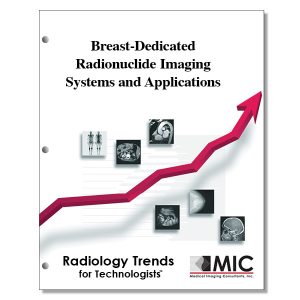

Breast-Dedicated Radionuclide Imaging Systems and Applications
Several breast-dedicated coincidence-photon and single photon imaging systems are described. Clinical results and future directions are discussed.
Course ID: Q00495 Category: Radiology Trends for Technologists Modalities: Mammography, Nuclear Medicine, PET, Radiation Therapy3.25 |
Satisfaction Guarantee |
$34.00
- Targeted CE
- Outline
- Objectives
Targeted CE per ARRT’s Discipline, Category, and Subcategory classification for enrollments starting after February 14, 2023:
Nuclear Medicine Technology: 3.25
Image Production: 0.25
Instrumentation: 0.25
Procedures: 3.00
Endocrine and Oncology Procedures: 1.50
Other Imaging Procedures: 1.50
Outline
- Part I: Breast-Dedicated Radionuclide Imaging Systems
- Introduction
- BD Positron Emission Mammography (PEM) and PET Camera Designs
- System Configuration
- Detector Design Issues
- BD Single-Photon Camera Designs
- System Configuration
- Detector Design Issues
- Tracer Development for BD Radionuclide Imaging
- Clinical Translation of BD Cameras
- Conclusion
- Part 2: Nuclear Breast Imaging: Clinical Results and Future Directions
- Introduction
- The Evidence
- Extent of Disease
- Screening
- Standardized Interpretive Criteria and Quantification
- Tumor Subtypes
- Future
- Summary
Objectives
Upon completion of this course, students will:
- know the roles that non-invasive molecular imaging can play in breast cancer evaluation
- be familiar with the current various breast-dedicated PET imaging detector configurations
- understand the disadvantages of translatable and rotatable BD PET imaging detector heads in comparison with stationary BD PET imaging systems
- know the typical patient positioning for fully tomographic BD PET systems
- be familiar with the differences in C-shaped ring and O-shaped ring BD PET detector systems
- understand the advantages of dual curved panels in PEM imaging systems
- be familiar with the methods to better image for potential lesions at the chest wall on BD PET systems
- understand the cause and effect of parallax blurring in BD PET systems
- be familiar with the current BD PET systems, their geometry and crystal types
- be familiar with the methods for creating crystal arrays that provide depth-dependent scintillation light behavior
- understand the effects of crystal size on BD PET systems that use discrete crystal elements
- know the effects of high crystal-packing fraction and stopping power in BD PET systems
- be familiar with the advantages of single-panel and dual-panel BSGI systems
- know the current crystal alternative to NaI for single-photon gamma camera systems
- be familiar with the collimator and spatial resolution specifications for the current BD single-photon gamma camera systems
- understand the major factors in scanner design affecting single-photon gamma camera systems
- know the collimator that can be utilized on BD single-photon gamma cameras to better image of the chest wall
- know the methods by which 99mTc Sestamibi targets cancer cells for imaging
- know why some tumors in the central breast are visible on only one of the two mammographic views in PEM systems
- know the ways in which BD PET systems have great potential in breast cancer treatment and evaluation
- be familiar with the clinical translation information of BSGI/MBI cameras
- know the advantages of combining MBI with mammography screening
- be familiar with the advantages of biopsy-compatible BD radionuclide imaging cameras
- know the radiopharmaceutical information and basics of lead shielding for the 99mTc-sestamibi and 18F-FDG imaging agents
- be familiar with the available options in dedicated breast gamma-camera imaging
- understand why mammographic technologists should be included in the patient positioning for nuclear breast imaging, at least for a minimum number of cases
- be familiar with the typical imaging delay time after injection, time for each acquisition, and total minimum time for a total nuclear breast imaging exam of both breasts
- know what additional views might be necessary to fully include all the breast tissue
- know the first use case type of the 99mTc-sestamibi radiotracer
- know the reason why approximately 1cm of tissue at the extreme posterior of the breast is not well evaluated on PEM
- know the type of breast PET systems that should improve visualization of posterior tissues
- understand how to improve lesion-to-background uptake in 18F-FDG-based imaging
- know patient preparation and post-injection instructions for both 99mTc-sestamibi and 18F-FDG-based breast imaging
- be familiar with the principles of dose limitation in medical imaging and radiation effective dose amounts for nuclear breast imaging
- know the organ that receives the highest radiation dose for 18F-FDG-based imaging studies
- be familiar with MRI’s ability to demonstrate additional occult disease in both the ipsilateral and contralateral breast tissue after a newly diagnosed cancer
- know the reason why percutaneous biopsy of additional suspicious findings is important after BSGI before converting a patient to mastectomy
- know how PEM and MRI compare for assessing disease extent in ipsilateral and contralateral breast tissue
- know the missing receptors of which triple-negative breast cancers consist
- be familiar with the reasons why neither 99mTc-sestamibi nor 18F-FDG imaging is reliable at identifying metastatic axillary adenopathy
- be familiar with the reasons for recommending annual breast cancer screening with MRI
- be familiar with the BIRADS terminology and format used for mammography, ultrasound, MRI, and now nuclear breast imaging assessments
- be familiar with situations in which background uptake of 99mTc-sestamibi can be greater than normal
- be familiar with the various types of breast cancer subtypes that can be imaged well with 18F-FDG
- be familiar with the various radiotracers that are not currently approved for clinical use for nuclear breast imaging in the US
